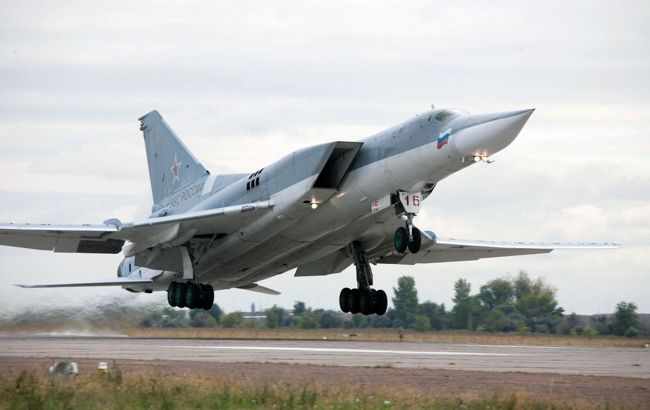Nuclear warfighter: Key characteristics of Russian Tu-22M3 bomber and Kh-22 'blind' missiles
 Russia again deploys Tu-22M3 for missile attacks (Photo: Russian media)
Russia again deploys Tu-22M3 for missile attacks (Photo: Russian media)
The Russian Federation once again attacks Ukraine using long-range strategic bombers Tu-22M3. The main threat lies in their launch of supersonic missiles like the X-22, which our air defense has never intercepted.
RBC-Ukraine provides a more detailed account of these aircraft.
In preparing the material, information from the Ukrainian Air Force, statements by Defense Ministry speaker Yurii Ihnat, data from Wikipedia, and information from the specialized resource Defense Express were used.
The mass rocket attack on Ukrainian cities was accompanied by launches of Kh-101/Kh-555 missiles, ballistic Kinzhals, and modified S-300/S-400 missiles adapted for ground targets. Additionally, at approximately 05:00, Russians deployed long-range Tu-22M3 bombers, firing eight cruise missiles Kh-22/Kh-32 toward the northern and central regions.
Overall, 114 out of 158 targets were successfully intercepted, consisting of missiles and combat drones named Shahed. There were no reports from the Air Force regarding the interception of Kh-22/Kh-32 missiles.
In the latter part of the day, Tu-22M3 launched several more missiles, but the results of this attack remain unknown.
About the Tu-22M3 aircraft
The Tu-22M family of aircraft (classified by NATO as Backfire) comprises Soviet and Russian long-range strategic bombers equipped with variable-geometry wings.
The project's development began in 1965 when the combat application of single-mode supersonic heavy bombers proved to be ineffective. The need for multi-mode aircraft capable of operating at various speeds and altitudes emerged. This was achieved through wings with variable sweep capability during flight.
 (1).jpg) Photo: Tu-22M3 aircraft is a Soviet development (russianplanes.net)
Photo: Tu-22M3 aircraft is a Soviet development (russianplanes.net)
Initially, the work was carried out as a deep modernization of the Tu-22K aircraft, with engines placed above the fuselage on both sides. The modifications mainly concerned the wings, but by 1967, the Tu-22M design underwent changes, and the prototype lost its similarity to its predecessor. A variant of the Tu-22M with a mid-positioned wing, air intakes on the fuselage sides, and engines in its tail section emerged.
The first Tu-22M0 appeared by mid-1969, and by the end of 1972, nine units were built. However, during flight tests, it was revealed that its primary flight characteristics were inferior to its predecessor. In December 1969, a decision was made to modernize it into the Tu-22M1. It was never put into service, as it was decided to produce the Tu-22M2 in a series.
The current version, the Tu-22M3, emerged in the mid-1970s. This modification incorporated more powerful and economical engines with a new management system. Changes were made to the design of air intake channels - the vertical wedge-shaped inlet device was replaced with a horizontal one. Other improvements involved the power supply system.
The new aircraft made its first flight in June 1977, and serial production concluded in 1993. During this period, 268 Tu-22M3 units were built.
Its predecessor, the Tu-22, acquired one of the worst reputations among Soviet aircraft. The reasons included high accident rates, and complexity in take-off and landing control, among others. Some engineering issues persisted with the Tu-22M3. For instance, in 2019, a plane of this model crashed while landing on the Kola Peninsula, and two years later, three crew members died due to emergency ejection system problems.
The exact number of operational Tu-22M3 aircraft in Russia today is unknown. Some experts estimate it to be no more than 60 units, with only half in a state of combat readiness.
After the collapse of the USSR, Ukraine received 22 Tu-22M2 aircraft and 60 Tu-22M3 aircraft. Later, 19 of them were transferred to Russia, four were kept for museum displays, and the rest were scrapped.
Characteristics and features of the aircraft for nuclear warfare
The Tu-22M3 was designed for nuclear warfare. The supersonic bomber was intended to release three supersonic missiles Kh-22 simultaneously, for instance, targeting an American aircraft carrier from a distance of less than 600 km.
The Kh-22 missile was primarily proposed in a nuclear configuration and had a significant margin of error. However, when targeting a large object, a circular deviation of 200-300 meters does not have a significant impact and ensures a 100% hit rate. Non-nuclear warhead missiles with a high-explosive fragmentation payload are used for strikes on Ukraine.
_1.jpg) Photo: Tu-22M3 in flight (flickr.com/Russian Air Force)
Photo: Tu-22M3 in flight (flickr.com/Russian Air Force)
Additionally, the aircraft can carry up to 12 tons of free-falling bombs while simultaneously launching cruise missiles. According to various estimates, one salvo could cover an area equivalent to 35 football fields.
Other specifications:
- Length - 42 m
- Height - 11 m
- Wingspan - from 23.3 to 34.3 m (depending on the sweep angle)
- Takeoff weight - 112 tons
- Maximum speed - 2300 km/h
- Service ceiling - 13,300 m
- Flight range - 6800 km
- Crew - 4 persons
The long-range capability of the missiles allows the Tu-22M3 to strike without entering the range of Ukraine's air defenses, which is the main challenge. In practice, the aircraft are positioned beyond the reach, although instances of damage to these aircraft have occurred.
For example, on December 5, 2022, due to drone strikes at the Dyagilevo airfield (western outskirts of Ryazan), a Tu-22M3 was damaged. Photos circulated showing damage to the tail section.
Subsequent strikes occurred in August 2023. Initially, on the 17th, during an attack on the Shaykivka airfield in the Kaluga region, one aircraft was damaged. Two days later, drones attacked the Soltsy airbase (the Novgorod region). Photos showed the Tu-22M3 engulfed in flames.
"The blind killer": Key facts about the Kh-22 missile
The Kh-22 missile is the only one compatible with the Tu-22M3 for ground strikes. It has extremely limited capabilities as it was originally developed as an anti-ship weapon in the mid-last century.
According to Defense Express, the Kh-22 uses a radar-homing warhead for targeting, which poorly detects ground objects. Hence, its typical targets include bridges or large buildings.
For instance, in May 2022, it demolished the House of Culture in Lozova, the Kharkiv region. The building stood out as the most radio-contrast structure in the area as it was isolated from others. The warhead's weight of 900-1000 kg resulted in extensive destruction.

Photo: Tu-22M3 with a suspended Kh-22 missile (aviation.ru)
The missile is very difficult to intercept. Initially, it ascends to an altitude of 22.5 km, accelerating to 4 Mach (over 4,000 km/h), and at the terminal stage, it attacks at an angle at speeds of 2 Mach (over 2,000 km/h). The launch range reaches up to 600 km but depends on the Tu-22M3 radar station's ability to discern the target.
Additionally, there is a modification of the Kh-22 without a radar-guided seeker, where hitting within a 10 by 10 km square is considered acceptable accuracy. Thus, the use of the Kh-22 for ground strikes indicates the depletion of Russia's high-precision missile stockpile.
After one of the summer attacks, Air Force spokesman Yurii Ignat stated that the Kh-22 flies at supersonic speeds and approaches the target on a ballistic trajectory, making interception more difficult.
"None of the Kh-22 missiles have been destroyed at all, not just today," he said in mid-August.
There is also information about the missile's modernization. In particular, in 2016, Russia received the Kh-32 version with increased range and improved accuracy.
"It's a modernized Kh-22. The question is how many of them have been produced. But the fact that they have already been used is certain," noted Ihnat.
It's worth noting that some of the most tragic events of the Russian-Ukrainian war are linked to the Kh-22 missiles. The first reports of their use appeared in the spring of 2022. For instance, in May, the Riviera shopping center near Odesa and the Kremenchuk oil refinery were attacked.
During the day on June 27, Russian forces struck the Amstor shopping center in Kremenchuk, where up to 1,000 people were present, and the Kredmash plant. The real target might probably have been the Kriukiv Bridge over the Dnipro River a couple of kilometers to the south. However, due to high circular deviation, one of the missiles hit the shopping center, resulting in the deaths of over 20 individuals.
Within a few days, Kh-22 missiles hit a multi-story residential building and two recreation bases in the resort town of Serhiivka in the Odesa region. At least 18 people died, and 30 others were injured.
On January 14, one of the Tu-22M3 bombers launched a missile from the Kursk region, hitting a multi-story building in Dnipro. Forty-six people, including six children, died then.
***
In just the first year of full-scale war, Russia released over 210 missiles of this type, and Ukrainian forces failed to shoot down any of them. Complexes like Patriot or SAMP-T are needed for effective counteraction.
As of today, Ukraine has no fewer than three Patriot batteries and one SAMP-T, which are insufficient to cover the entire territory. It's probable that the enemy is targeting areas that lack defense, as there have been no reports of interceptions in 2023.

